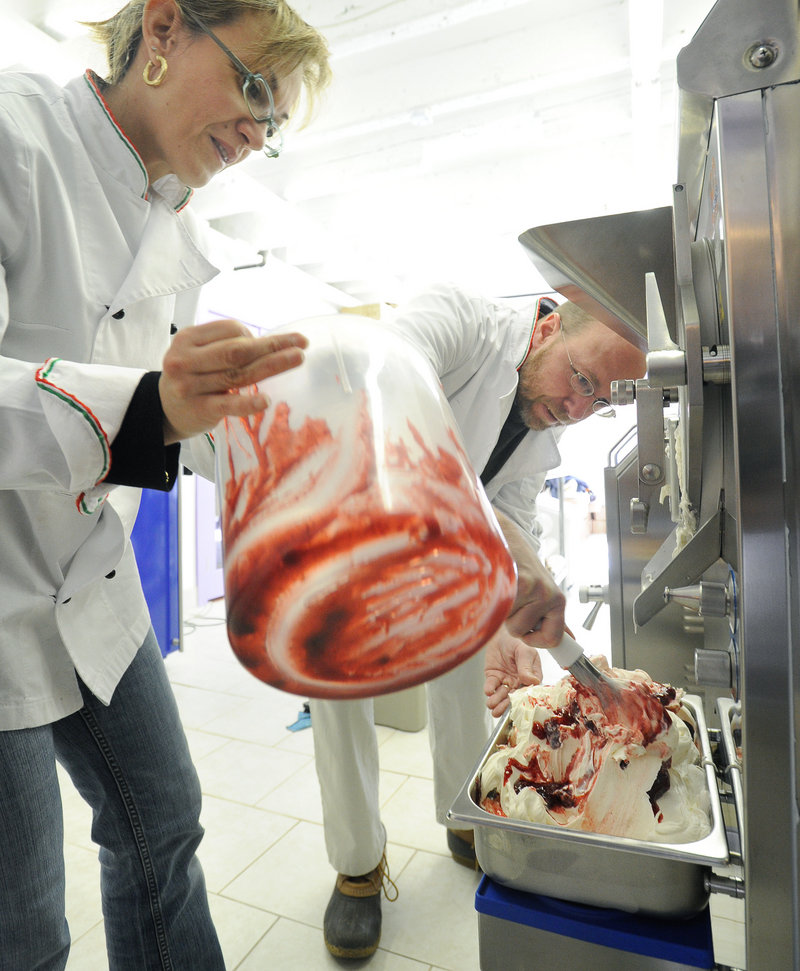PORTLAND – After a few minutes of trying to blend wild berries into a batch of fresh-made gelato with a small spoon, I understood why somebody a long time ago invented the electric mixer.
The gelato — though just milk, cream and sugar — was thick and heavy as I tried to stir the berries into it. My hands were tired in a matter of minutes.
But I didn’t have minutes to waste, master gelato maker Mariagrazia Zanardi told me.
“I have to be fast when I do this, because if it melts it changes the molecular structure,” said Zanardi, 44, showing me how to quickly mix the berries into the gelato. “I’m not a strong woman, so this is hard work. After this I don’t have to go to the gym.”
Zanardi’s talk of the gelato’s “molecular structure” struck me. When eating ice cream, or gelato, or other similarly sweet treats, I had never thought much about molecular structure.
But Zanardi does, almost constantly. She studied gelato-making at a university in Italy, then moved to Portland and opened Gorgeous Gelato on Fore Street in December, with her husband, Donato Giovine. Giovine had a packaging business in Milan, and Zanardi had been a Spanish teacher before deciding upon gelato-making as a second career.
And it was the science of gelato-making that really seemed to appeal to her. She did not want to open a gelato shop and just pour some ready-mix ingredients into a bowl and serve it up.
“When I studied, I learned about the science of it, how everything works together,” said Zanardi. “It’s not just the taste of ingredients.”
For instance, Giovine showed me a box of crushed cookies as an example of how particular Zanardi is about molecular structure.
A food supplier gave them the crushed sandwich cookies — probably broken during production — when they said they wanted to make an Oreo-flavored gelato. The food supplier thought crushed cookies similar to Oreos would work, but Zanardi and Giovine said no way.
“We wanted Oreo biscuits, the real ones, and not ones already crushed,” said Giovine. “In Italy, we have strict laws about food and what you can use.”
When I helped her make the wild berry gelato, Zanardi explained to me that she wanted wild berries, and not cultivated berries, because of the difference in — you guessed it — molecular structure. Even so, the “stability” of a gelato using berries is less than gelato using almonds or pistachios, she told me.
At some point, I asked Zanardi what the big difference was between gelato and ice cream. She didn’t hesitate — air and fat. Gelato is supposed to have a lot less of both.
She said that gelato is maybe 25 percent air, and many types of ice cream have three times that much. Also, a lot of premium ice creams use “industrial butterfat,” Zanardi told me. Gelato uses whole milk and heavy cream and has maybe 70 percent less fat overall.
So it’s good for me?
It certainly tasted good. When we mixed the wild berries into that gelato, I tasted some and was blown away by the flavor and texture. It was almost chewy, if frozen milk can be such a thing.
“The way to taste gelato is to let it sit between your lips and tongue for a time. Don’t just slide it down,” Zanardi said.
The gelato-making process in Zanardi’s kitchen begins with letting the basic ingredients — milk, heavy cream, sugar — sit in a “hot mixer” machine for somewhere between 14 to 24 hours. It sits at a temperature just above freezing, maybe 34 to 40 degrees. For some smaller batches, she does the initial heating on a stove.
After the hot mixer, the gelato goes into a batch freezer, a machine the size of a small refrigerator. I helped pour the mixture, still a liquid, into the batch freezer. It didn’t take long for the gelato to become the consistency of taffy and come out of the batch freezer into a pan the size of a baking dish.
After the batch freezer, the gelato gets its extra ingredients mixed in — nuts, caramel, berries, etc. Then it goes into a blast freezer, where it becomes ready for the serving case.
The serving case is kept around 4 degrees, but even then Zanardi checks the temperature every two hours. Some areas of the case get a little warmer over time, and others get cooler, so Zanardi wants each flavor of gelato to have just the perfect temperature for keeping its unique — wait for it, wait for it — molecular structure.
At one point, I helped Zanardi weigh wild berries for the gelato. Like everything Zanardi does with her gelato, this was an exact science. The weight had to be exact, or it would change the makeup of the gelato. So when I went a little over the needed weight while spooning berries onto the scale, Zanardi had me take some out. Then put some in. Then take some out.
I did this for a while, dripping berries on the container, scale and myself.
Finally, when only a tiny amount of berries was needed to get the weight exact, Zanardi took her finger, got a tiny dollop on her fingertip and plopped it on the scale. The weight was exact.
“See, that’s what you do. You get your hands dirty doing this job,” she said.
But the cleanup is delicious.
Staff Writer Ray Routhier can be contacted at 791-6454 or at:
rrouthier@pressherald.com
Send questions/comments to the editors.



